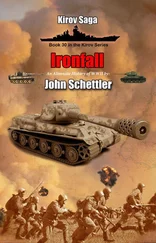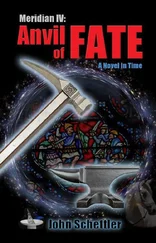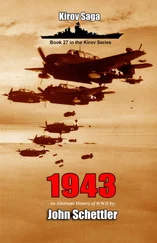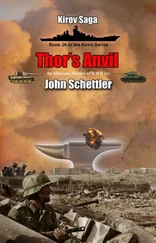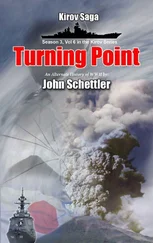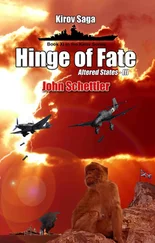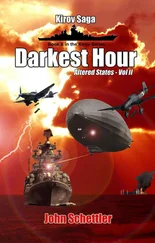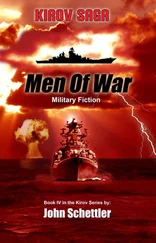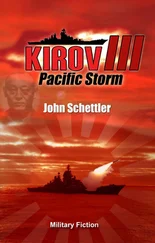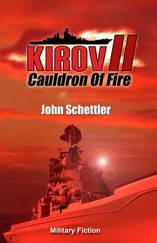John Schettler - Kirov
Здесь есть возможность читать онлайн «John Schettler - Kirov» весь текст электронной книги совершенно бесплатно (целиком полную версию без сокращений). В некоторых случаях можно слушать аудио, скачать через торрент в формате fb2 и присутствует краткое содержание. Жанр: Фантастика и фэнтези, Альтернативная история, на английском языке. Описание произведения, (предисловие) а так же отзывы посетителей доступны на портале библиотеки ЛибКат.
- Название:Kirov
- Автор:
- Жанр:
- Год:неизвестен
- ISBN:нет данных
- Рейтинг книги:5 / 5. Голосов: 1
-
Избранное:Добавить в избранное
- Отзывы:
-
Ваша оценка:
- 100
- 1
- 2
- 3
- 4
- 5
Kirov: краткое содержание, описание и аннотация
Предлагаем к чтению аннотацию, описание, краткое содержание или предисловие (зависит от того, что написал сам автор книги «Kirov»). Если вы не нашли необходимую информацию о книге — напишите в комментариях, мы постараемся отыскать её.
Kirov — читать онлайн бесплатно полную книгу (весь текст) целиком
Ниже представлен текст книги, разбитый по страницам. Система сохранения места последней прочитанной страницы, позволяет с удобством читать онлайн бесплатно книгу «Kirov», без необходимости каждый раз заново искать на чём Вы остановились. Поставьте закладку, и сможете в любой момент перейти на страницу, на которой закончили чтение.
Интервал:
Закладка:
“Abort the missile, Mister Gromenko,” said Volsky, but at that moment the power wavered, winked off briefly, then back on. Volsky knew what had happened, his face calm and resolved. When the battle bridge went active the systems on the main bridge had all gone dark. Karpov must have realized what was happening and rushed to the emergency reset. He was attempting to regain control of the ship’s systems even as Gromenko pressed the missile abort, and that brief interval of chaos, where two computer systems wrestled for control of the energy pulsing through cables and wires all over the ship, was enough to interfere with the abort action-almost enough.
The missile received a pulsing command to interrupt its programmed flight path and nose down into the sea. Its engines cut off abruptly, but it was still moving at an incredible rate of speed. Three seconds later it would again be sent a renewed order to abort as Gromenko frantically pushed the button on his panel, this time to disable its warhead…but when the signal arrived the missile was not there. Two seconds earlier it had plunged into the sea, some 500 meters short of its intended impact point, and ignited.
Aboard DD Plunkett, Captain Kaufman was desperately shouting orders to his helmsman to zigzag his ship forward into the teeth of the enemy gunfire. The maneuver was futile, as the enemy guns were not trained and fired by men with optical sighting. A computer had hold of them now in the hard electronic grip of its radar. Lasers also targeted his ships for an added measure of accuracy. His ship was hit and on fire, as were Benson, Mayo, Jones, Gleaves and Hughes, and all eight destroyers of Desron 7 were now making smoke in an attempt to mask their brave charge and get within torpedo firing range, though the smoke did nothing whatsoever to deter Kirov’s gunfire. Kaufman suddenly saw what he first thought to be lightning on the horizon, then a bright wash of white smoke and fire coming from the distant enemy vessel. At first his heart leapt with the thought that one of his destroyers has scored a direct hit on the enemy with a 5 inch deck gun, but he was only seeing the smoke and ignition of the lethal MOS-III Starfire as it first launched.
Something moved with terrible speed, a small fire in its wake, and a long yellow tail fading to russet orange as it sped off to the east of his position. He took heart for a moment, thinking TF 16 must be pressing in from the east. Then, a long minute later, the sky itself seemed to ignite with light and fire, as if a massive thunderbolt had struck the sea, flung down by an unseen angry god. The light was so bright that he flinched, turning his head away and instinctively holding up a hand to shield his eyes. What in God’s name were the Germans firing now?
~ ~ ~
On the main bridge Karpov smiled inwardly when he heard the Starfire eject an ignite its motors. As it rocketed away he allowed himself the barest edge of an upturned lip in a restrained grin. Yet the enemy destroyers came to mind again, and he decided to bring more guns to bear.
“Helm, starboard thirty and come about on three-one-five! Samsonov, bring the two aft 152mm batteries on line and stop those destroyers!”
Desron 7 was still bravely charging through the smoke and fire, blooded but undaunted, and closing on torpedo firing range. Kirov came about in a tight turn, her aft deck guns now blazing away as she did so, pulsing out shells at an alarming rate of fire. A few seconds later, however, the systems on the bridge all winked, fluttered, and then went dark. Only the dim red overhead battle lights remained on.
“That bastard!” Karpov immediately knew what had happened. The Admiral was loose and on the secondary battle bridge, a feature unique to Kirov, and unlike any other ship in the world. He rushed to a wall panel, flipping open the clear plastic casing for the emergency reset. There would be no time to re-enter his command key and request dual control by code. He had to insure the telemetry link to the missile remained intact, and he only needed a few seconds. The ‘Fire and Forget’ guidance system on the MOS-III was disabled when the nuclear warhead was mounted. It required a command link to the mother ship, the last vestige of restraint as a fail-safe on the use of nuclear weapons. Kirov held the ever extending electronic rein on the weapon, with one last chance to pull back and hold it in check.
Karpov pulled heavily on the reset switch, yanking it down into the ON position and seeing the immediate surge of battery backup power enliven the command systems on his bridge, but it was the barest flutter. Somewhere, deep within the ship, another computer sat as judge and jury on the matter.
It was the Admiral’s ignition key that had initiated operations on the ship when he first stepped aboard and took over official command for the scheduled missile trials, and though Karpov’s command key had successfully ordered the missile fire, it was the Admiral’s key that was now activating the secondary systems on the battle bridge, and that command postdated the former. The computer saw the reset request when Karpov threw his switch, yet it endowed Volsky’s keyed command as a new and superseding order, dismissing Karpov’s plaintive action with prejudice. It closed the switches that would feed power to the main bridge, which remained dark, and it would stay that way until a second valid command key was inserted and a request for dual operations was properly coded and approved. Yet Karpov’s desperate attempt to wrest control from the Admiral had been enough to impede the abort command…
The Starfire fell into the sea, and the momentum of the missile took it over a hundred feet beneath the water before the 15 kiloton warhead exploded and sent a massive wall of white seawater blasting up thousands of feet into the sky. It was considered a small tactical nuclear warhead in Kirov’s day, but was roughly the size of the weapons the Americans would drop on Hiroshima and Nagasaki this very same week, just four years later. It fell just ahead of Task Force 16 where the Mississippi lumbered forward into the battle, and the leading destroyer Captains quailed at what they saw.
Upon detonation the weapon ignited to a blast wave of highly compressed superheated gas and vapor, which propelled millions of cubic feet of water straight up in an immense geyser. Enormous fists of seawater surged out from this central core, rising and then slowly falling, as if hammering down to smash anything that remained on the sea. Then the base of the geyser thickened as a huge surge of water radiated out in all directions, a wall of seething ocean hundreds of feet high that rolled away from the detonation like a colossal pyroclastic flow from a volcanic eruption. Above this, a steaming cloud spread out until it encompassed a width of nearly five kilometers.
The battleship Mississippi and the rest of the ships in Task Force 16 would face surging waves from the first atomic weapon ever detonated on planet Earth. The lead destroyers were swamped by the massive wall of water, tossed up and about like bits of broken wood, so much flotsam on the raging seas. The massive tsunami smashed into cruisers Quincy and Wichita, snapping the former in half and rolling the latter over beneath a million of tons of water, dragging her crushed and mangled hull and superstructure beneath the waves. Lastly, trailing some distance behind the screen of five ships, Mississippi was ready to meet her fate.
Captain Wright stared in awe at the gigantic column of water, 1500 feet in height, its walls 200 feet thick at the base of the eruption. Then the much smaller tsunami generated by the detonation careened over his ship, smashing into the battleship and rolling her completely over on her starboard side. It was as if a hurricane blast of wind and sea water had been conjured out of thin air and sent roiling down upon the ship from heaven above. That was not too far from the truth.
Читать дальшеИнтервал:
Закладка:
Похожие книги на «Kirov»
Представляем Вашему вниманию похожие книги на «Kirov» списком для выбора. Мы отобрали схожую по названию и смыслу литературу в надежде предоставить читателям больше вариантов отыскать новые, интересные, ещё непрочитанные произведения.
Обсуждение, отзывы о книге «Kirov» и просто собственные мнения читателей. Оставьте ваши комментарии, напишите, что Вы думаете о произведении, его смысле или главных героях. Укажите что конкретно понравилось, а что нет, и почему Вы так считаете.

